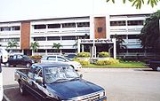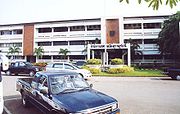
Thesaban
Encyclopedia
Thesaban are the municipalities in Thailand
. There are three levels of municipalities - city, town and subdistrict municipality. Both Bangkok and Pattaya are special municipal entities outside the thesaban system.
 The municipalities take over some of the responsibilities which are assigned to the districts (amphoe
The municipalities take over some of the responsibilities which are assigned to the districts (amphoe
) or communes (tambon
) for the non-municipal (rural) areas.
The thesaban system was established in the Thesaban Organization Act of 1934 , and has been updated several times since, starting with the Thesaban Act of 1939 , which was replaced by the Thesaban Act of 1953. The 1953 act was most recently amended by the Thesaban Act (No. 12) of 2003.
When first organized in 1934 the minimum qualifications for city status were a population of 30,000 with a density of 1,000 per km². In 1939 the required population density was increased to 2,000 per km², along with the addition of a financial requirement. In 1953 the population density requirement was again raised, to 3,000 per km², before being removed entirely in 2000.
When first organized in 1934, minimum qualification for town status was a population of 3,000 with a density of 1,000 per km². In 1939 requirements were increased to a population of 5,000 with a density of 2,000 per km², plus a financial criterion. In 1953, the minimum population requirements was raised to the present value; the population density was also raised, to 3,000 per km², before being removed entirely in 2000.
); i.e., it may not cover a tambon completely, or conversely, it may extend over parts of more than one tambon.
For an area to qualify as a thesaban tambon, it must have a gross income of at least 5 million baht and a population of at least 5,000 with a minimum density of 1,500 per km², plus a consensus of the population within that area.
Most thesaban tambons today were originally sanitation districts (sukhaphiban
), all of which were converted in May 1999, though many of them did not actually meet the criteria above.
Thailand
Thailand , officially the Kingdom of Thailand , formerly known as Siam , is a country located at the centre of the Indochina peninsula and Southeast Asia. It is bordered to the north by Burma and Laos, to the east by Laos and Cambodia, to the south by the Gulf of Thailand and Malaysia, and to the...
. There are three levels of municipalities - city, town and subdistrict municipality. Both Bangkok and Pattaya are special municipal entities outside the thesaban system.

Amphoe
An amphoe is the second level administrative subdivision of Thailand. Usually translated as district, amphoe make up the provinces, and are analogous to a county seat...
) or communes (tambon
Tambon
Tambon is a local government unit in Thailand. Below district and province , they form the third administrative subdivision level. As of the 2009 there are 7255 tambon, not including the 169 khwaeng of Bangkok, which are set at the same administrative level, thus every district contains 8-10 tambon...
) for the non-municipal (rural) areas.
The thesaban system was established in the Thesaban Organization Act of 1934 , and has been updated several times since, starting with the Thesaban Act of 1939 , which was replaced by the Thesaban Act of 1953. The 1953 act was most recently amended by the Thesaban Act (No. 12) of 2003.
Cities
Thesaban nakhon is usually translated as city. To qualify for city status a municipality needs to have a population of at least 50,000 and sufficient income to carry out the tasks of a city.When first organized in 1934 the minimum qualifications for city status were a population of 30,000 with a density of 1,000 per km². In 1939 the required population density was increased to 2,000 per km², along with the addition of a financial requirement. In 1953 the population density requirement was again raised, to 3,000 per km², before being removed entirely in 2000.
Towns
Thesaban mueang is usually translated as town. For a municipality to qualify as a town, it either needs to be a provincial capital, or have a population of at least 10,000 and sufficient income to cover the tasks of a town.When first organized in 1934, minimum qualification for town status was a population of 3,000 with a density of 1,000 per km². In 1939 requirements were increased to a population of 5,000 with a density of 2,000 per km², plus a financial criterion. In 1953, the minimum population requirements was raised to the present value; the population density was also raised, to 3,000 per km², before being removed entirely in 2000.
Townships
Thesaban tambon is the lowest level municipal unit. Despite the name, it may not necessarily cover the same area as a subdistrict (tambonTambon
Tambon is a local government unit in Thailand. Below district and province , they form the third administrative subdivision level. As of the 2009 there are 7255 tambon, not including the 169 khwaeng of Bangkok, which are set at the same administrative level, thus every district contains 8-10 tambon...
); i.e., it may not cover a tambon completely, or conversely, it may extend over parts of more than one tambon.
For an area to qualify as a thesaban tambon, it must have a gross income of at least 5 million baht and a population of at least 5,000 with a minimum density of 1,500 per km², plus a consensus of the population within that area.
Most thesaban tambons today were originally sanitation districts (sukhaphiban
Sukhaphiban
Sukhaphiban were an administrative division of Thailand.Sanitary districts were the first sub-autonomous entities established in Thailand. A first such district was created in Bangkok by a royal decreee of King Chulalongkorn in 1897...
), all of which were converted in May 1999, though many of them did not actually meet the criteria above.
See also
- List of cities in Thailand by population
- List of cities in Thailand
- Subdivisions of Thailand
External links
- History of administrative reforms
- http://www.tessaban.com

